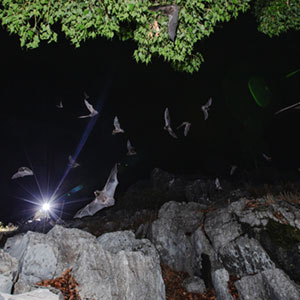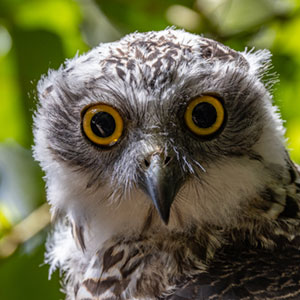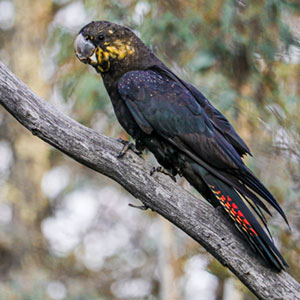Love
So much to learn, so much to love
Tall and handsome Sydney Blue Gums (Eucalyptus saligna) tower up to 50 metres high with smooth, blueish-grey trunks and their signature brown bark “socks” at their base. They’re one of the most common tree species making up the ecological community known as 'Blue Gum High Forest' and you will often find them contrasted amongst luminescent green fernery and other forest stunners.
So Rare
Only an estimated 5% of the original Blue Gum High Forest remains. This ecological community has specific soil and rainfall requirements that limit where it can occur. The critically endangered Blue Gum High Forest’s survival is overwhelmingly dependent on Hornsby Shire and its people.
Where love grows
Blue Gum High Forest grows in 14 suburbs within Hornsby Shire, in and amongst the places where over 99,000 people live. If you live in or near these suburbs, then Blue Gum High Forest is your neighbour: Arcadia, Beecroft, Castle Hill, Cherrybrook, Dural, Galston, Glenhaven, Hornsby, Normanhurst, Pennant Hills, Thornleigh, Wahroonga, Westleigh, West Pennant Hills.
Why does it only grow in a third of Hornsby Shire’s suburbs?
Blue Gum High Forest has specific soil and rainfall requirements which, when added together, limit where it can grow. Some trees in a Blue Gum High Forest need rich, deep soils to support their straight and tall growth. Such soils form from weathered shale rock or have volcanic origins. The second essential ingredient is a rainfall total above 1100mm (on average) per year. Where Hornsby Shire’s suburbs have this soil and rainfall combination, and where it hasn’t been cleared, you will find Blue Gum High Forest.
Jurassic Park on your doorstep
Hornsby Shire contains 40% of the world’s Blue Gum High Forest! Yet, within some of our patches grows an even rarer sub-type of Blue Gum High Forest called 'Blue Gum Diatreme Forest'.
This 14-hectare sub-forest community of outstanding majesty is so rare it can only be found in Hornsby Valley or nearby Fox Valley. It gets its name because it occurs on soils formed from eroding diatremes - volcanic pipes of magma that forced their way to the surface some 200 million years ago when dinosaurs roamed the Earth.
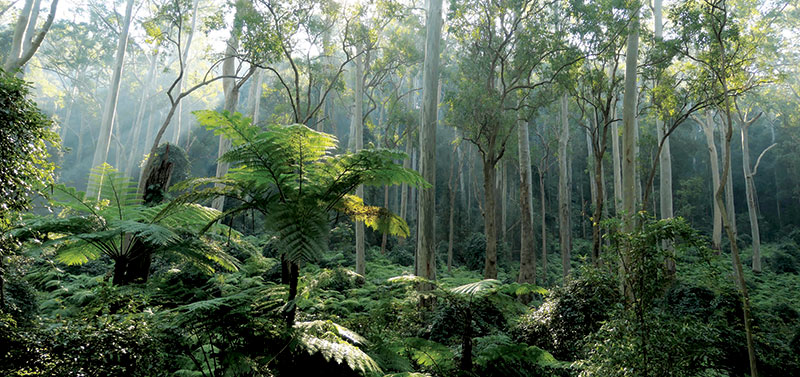
Blue Gum High Forest is not just a stand of majestic trees. Rather, it's a unique and complex community of plants, animals, fungi, and other organisms. Everything living in or visiting an ecological community contributes to its health.
Ecological communities are created by nature over thousands of years, so once it is gone, it cannot be replaced.
Meet your (wild) neighbours
Many species making up Blue Gum High Forest are quite common, however others, such as the powerful owl, glossy black-cockatoo, and several microbats are currently threatened with extinction.
Photo credits: 1. Large bent-winged bats (Miniopterus orianae oceanensis) - Alex Pike/DCCEEW
2. Powerful owl (Ninox strenua)
3. Female glossy black-cockatoo (Calyptorhynchus lathami)
Protecting threatened wildlife = protecting hollows
One key feature of Blue Gum High Forest is the hollows that form in mature trees. These play a vital role in providing homes and nesting sites for many native animals.
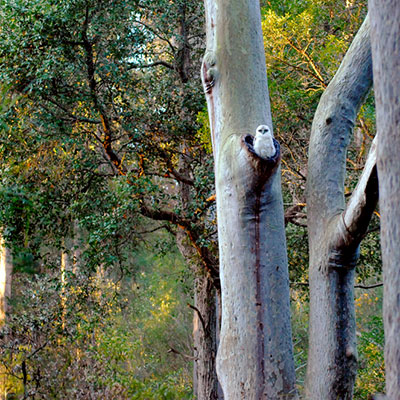 The powerful owl, for example, is Australia's largest owl and its survival depends on large hollows that usually only form in trees at least 150 years old. Similarly, the glossy black-cockatoo requires large hollows of at least a metre in depth, so it too relies on trees aged over 150 years for breeding.
The powerful owl, for example, is Australia's largest owl and its survival depends on large hollows that usually only form in trees at least 150 years old. Similarly, the glossy black-cockatoo requires large hollows of at least a metre in depth, so it too relies on trees aged over 150 years for breeding.
Due to the former logging industry of Hornsby Valley which sought the timber of the tallest Sydney blue gums; expansive farmland clearing, and ridgeline suburb expansion where Blue Gum High Forest normally thrives, our local wildlife is faced with a critical shortage of large hollow bearing, older trees.
It is crucial, therefore, that we preserve mature tree hollows by protecting standing trees (both living and dead) wherever possible.
Resources
For an in-depth Blue Gum High Forest profile go to the Australian Government’s Species Profile and Threats Database for the Blue Gum High Forest of the Sydney Basin Bioregion Or try the NSW Government’s Threatened biodiversity profile search tool.
When an outpost of the British Empire settled in Sydney some 240 years ago, Blue Gum High Forest quickly became highly regarded for its straight, tall trees and its rich, moist soils. Its trees were felled for their timbers, and the forest was progressively cleared for agriculture. With transport corridors concentrated on the ridge lines where it mainly grows, and with increasingly dense urban development, Blue Gum High Forest was almost squeezed out of existence. Today less than 5% of its area remains, and Blue Gum High Forest is facing an extremely high risk of extinction. In fact, less than 200 hectares of Blue Gum High Forest exists on the entire planet, and the scattered and narrow patches left are under immense pressure.
Blue Gum High Forest is listed by the NSW Government and the Australian Government as a critically endangered ecological community. Once it is gone, it cannot be replaced!
The small amount of Blue Gum High Forest remaining is subject to pressures that threaten its health and survival. Sustainably looked after for tens of thousands of years by traditional custodians, everything changed for Blue Gum High Forest when Europeans arrived in Hornsby Shire. Beginning in the late 1700s, trees were felled for timber followed by wide-spread clearing of the forest for farming. With the construction of railway lines and road expansion, suburbs replaced the once-rural areas. As Sydney's population grew, land-use development continued a-pace and the forest was almost squeezed out of existence. You can find out more by reading Hornsby Thematic History.
Today, Blue Gum High Forest is still under threat from many factors. Left alone and without help, these negative impacts would accumulate, and Blue Gum High Forest could quickly decline and become extinct.
Weeds
Exotic plants, including weeds and garden escapees, constantly enter bushland and can take over all layers of a forest. This is especially the case along bushland edges and waterways, and in small or narrow patches of bushland that are surrounded by development. Think again if you don’t believe there are plants that can overpower the mighty Sydney Blue Gum and other canopy trees. Groundcover weeds such as Wandering Trad (Tradescantia fluminensis) can completely block the light reaching the forest floor. No matter how robust the tree, their seeds and seedlings need space and light to germinate and grow. This can’t happen with a thick blanket of weeds covering the ground.
Stormwater
As deep soils are replaced by concrete and bitumen for roads and footpaths, and buildings and facilities for the Shire’s growing population, there is increasingly less space for rain to be slowly absorbed into the ground where it falls. Now when it rains, urban creeks become raging torrents fed by pipes and gutters channelling water that has fallen on these hard surfaces quickly into our natural waterways and bushland. Along the way, this stormwater will carry with it any seeds or plant parts swept up in its path, loose soils, and nutrients such as fertilisers. With creeks flowing higher and faster than is natural, stormwater can reach far into bushland, laying down nutrient-rich sediments. Many bushland weeds thrive in these conditions and their growth can out-compete the native bushland plants. With much bushland located downslope of developed areas, water shedding directly from neighbouring properties can also give weeds the upper hand on the edges of bushland. Council’s Catchment Remediation Program of the last few decades continues to reduce the magnitude of these impacts. Council’s Water Sensitive Hornsby Strategy assesses the Shire’s water sensitive performance and sets a Vision for 2040.
Dumping
Dumping is where natural or manufactured materials are taken into the forest, or moved within the forest, and left there. Natural materials include soil, rock and garden or tree prunings. Manufactured materials found in bushland include concrete and other building materials, discarded items such as furniture, and waste. Building up land or dumping material on top of the forest’s natural ground surface can starve the soil of oxygen and light. Seeds can’t germinate beyond a certain depth, and roots and other living things below the ground need oxygen to survive. The patch of forest affected cannot regenerate and its health declines.
Clearing
Clearing of Blue Gum High Forest is not just limited to the cutting down of trees but involves the removal or killing of any of the plants (including shrubs, grasses and groundcovers) which make up this unique ecological community. Unauthorised clearing is a threat to the survival of Blue Gum High Forest. It includes private properties encroaching onto public land to create extra space, cutting or poisoning of trees and plants to improve views or access to sunlight or to prevent leaves and branches dropping into properties, track building to access natural areas and concerns about bush fire. Depending on the extent, some of these activities can be authorised by governments, including local Councils and state and national governments. If not authorised, and because of the critically endangered status of Blue Gum High Forest, these clearing activities can be considered illegal.
Clearing of Blue Gum High Forest is exacerbated by the digging up of soil by hand tools or machines. Blue Gum High Forest contains many living things below the ground surface. Digging up soil damages the future of the forest (in the location it occurs) by removing roots and vital stores of seed and the underground stems, bulbs and tubers of various plants. Digging also damages the roots of trees and other plants that grow alongside the cleared area.
Depending on the extent, some clearing activities can be authorised by governments, including local Councils. The reason why approvals may be granted is to provide places for people to live, work and recreate, or to manage risks to life and property. Any approval process requires rigorous environmental assessments, and options must be considered that reduce or eliminate any impacts on the forest.
Disease
Phytophthora and Myrtle Rust are exotic pathogens that damage bushland ecology and cause the death of plants in certain susceptible areas. These diseases can be spread by people moving through bushland and unknowingly picking up pathogens on their shoes and clothes.
Guided by Council’s Biodiversity Conservation Strategy, Council has specialised staff and contractors who work to protect and repair bushland in parks and reserves and in selected unmade road reserves. Bush regeneration contractors restore bushland at around 80 sites across the Shire, including 21 Blue Gum High Forest sites. Bushcare volunteers work at 65 sites across the Shire, guided by specialist site supervisors employed by Council. Twelve (12) of these Bushcare groups work at Blue Gum High Forest sites.
Entrusted with looking after a precious forest teetering on the edge of extinction, Council must carefully assess and plan any work and activities that could damage Blue Gum High Forest in parks and reserves. With the aim being the forest’s long-term survival, Council conducts and supports plant and animal surveys to measure the forest’s health and to keep an eye on its wildlife and other dependents. A sound understanding of each patch of Blue Gum High Forest and its place in the Shire’s wider bushland network is essential. From an environmental impact perspective, the location and design of any proposed tracks and trails, shared pathways, play spaces and stormwater drainage devices (to name just a few) can be guided by survey findings. Options can be considered, and decisions made to ensure protection of critically endangered forests into the future is given the highest priority.
Council warmly invites the community to visit the parks and reserves where Blue Gum High Forest grows to experience its majesty and to appreciate and understand the ways of nature. Critical to the survival of the forest are human interactions that support its health and ongoing sustainability. As for precious works of art like Leonardo da Vinci’s Mona Lisa or Michelangelo’s David, access to and through Blue Gum High Forest must be appropriate and carefully managed.








